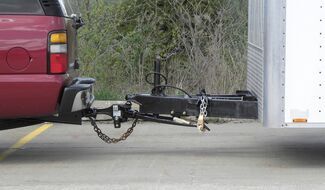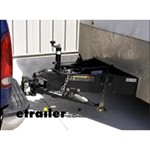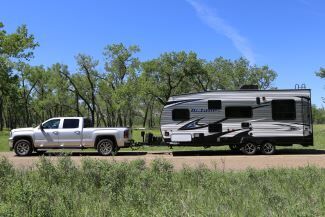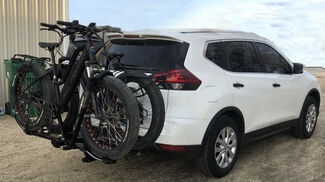
Weight Distribution for 2007 Chevy Tahoe LTZ Towing 2012 Titan Primo 2-horse Trailer
Question:
I have recently upgraded from a 2001 Chevy Tahoe LT to a 2007 LTZ Tahoe, and I was using the standard weight-distributing/anti-sway hitch that the trailer dealer installed on my trailer when I bought it, along with the obligatory brake controller... the first thing I noticed was that because I no longer have a step bumper, the trailer hitch receiver is much higher in the 2007 than the 2001 model, and I am afraid that this will create problems in hooking up my trailer now. A gentleman that I met at a recent horse show told me that the Strait-Line product was by far the safest and easiest WDH on the market, but looking at all of the pictures I am not able to figure out if its going to be able to adjust in order to accommodate my new, higher receiver hitch height. I worry about this because we recently had to tow my horse trailer with a friends husbands truck, a Silverado with a much higher hitch height, and the three of us had to literally stand on the bumper and bounce it down in order to get the trailer connected... while this was entertaining for onlookers, its not optimal for day-to-day operations, especially when I am needing to hook up without the assistance of a small army of friends. My best guess is that, fully loaded, the trailer weighs close to 6000 lbs. The reason I am considering a different WDH is that while the one I have now did a fine job of sway control with the 2001 Tahoe, it did not seem to adequately send enough weight to the front of the towing vehicle, leaving the rear end of the vehicle about 1-1/2inch lower than without a load, and I would like to correct this in order to make it safer to steer with all four wheels getting the same amount of weight distributed to them. Both new and old vehicles are equipped with AutoRide and the new Tahoe has Stabilitrac and all the other bells and whistles. Thanks for any advice.
asked by: Barbara
Expert Reply:
If your old system was not properly adjusted or was overloaded, it would explain why not enough weight was transferred to the front vehicle axle. Generally speaking, tilting the weight distribution head back toward the trailer will distribute more weight to the front axle of the tow vehicle, as will using fewer links in a chain-hanger type system. Your old system might indeed still be usable, if its capabilities are compatible with the weight of your trailer. Consult the set-up instructions for your particular system for details.
As far as the hitch height goes on your new vehicle, a weight distributing shank with a longer rise/drop might be necessary. I will link you to our Ball Mount FAQ page, which will walk you through the procedure for determining the proper rise or drop needed. Although the article specifically addresses ball mounts, the procedure for measuring would be the same for a weight distributing shank. If you find that you need a shank with a higher rise or drop, please reply with the manufacturer and model of your existing system and I will recommend an appropriate replacement.
I wholeheartedly agree with what the gentleman at the horse show was telling you. The Reese Strait-Line is the best weight distribution/sway control system I have encountered.
Reese recommends you start your vehicle and put a slight load on the rear of the vehicle to let the auto suspension begin to level the vehicle. Next, you will want to measure the distance from the ground to the top of the front wheel wells. Then you will want to hitch up your trailer and set up your weight distribution system according to the system instructions. Next, you will want to go back and measure the distance from the ground to the top of the front wheel well again.
You mentioned that your trailer weighs about 6000 lbs when ready to tow, which would place your tongue weight in the 600-900 lb range, as tongue weight is typically between 10 to 15 percent of the fully loaded weight of the trailer. For the purposes of choosing a system, keep in mind that the weight of anything stored in the cargo area of the Tahoe behind the rear vehicle axle should be considered as tongue weight. If your tongue weight is closer to 15 percent of the trailer weight and you regularly haul a few hundred pounds of gear in the rear of the Tahoe, you might actually need a higher rated system.
I have linked you to a good FAQ article that shows how to accurately determine your actual tongue weight. If you could reply with the actual tongue weight of the trailer, the weight of anything stowed in the rear of the Tahoe and the rise or drop of the shank needed, I would be happy to recommend a system for you should you decide you want to replace your existing one.

Product Page this Question was Asked From
Strait-Line Weight Distribution System w/ Sway Control - Trunnion Bar - 12,000 lbs GTW, 1,200 lbs TW
- Weight Distribution Hitch
- WD With Sway Control
- Some Sway
- Includes Shank
- Electric Brake Compatible
- Fits 2 Inch Hitch
- Allows Backing Up
- 1000 lbs
- 1100 lbs
- 700 lbs
- 800 lbs
- 900 lbs
- Reese
more information >
Featured Help Information
Instructions
Miscellaneous Media

Continue Researching
- Shop: SumoSprings Solo Custom Helper Springs - Rear Axle
- Shop: Suspension Enhancement
- Shop: Trailer Hitch
- Shop: Reese Pro Round Bar Weight Distribution w Sway Control - Round Bar - 11,500 lbs GTW, 1,150 lbs TW
- Shop: Redarc Tow-Pro Liberty Brake Controller - Dash Knob - 1 to 2 Axles - Proportional
- Shop: Curt Echo In-Line Bluetooth Brake Controller w/ OneControl App - 1 to 4 Axles - Proportional
- Shop: SumoSprings Solo Custom Helper Springs - Rear Axle
- Search Results: curt echo
- Shop: Brake Controller
- Q&A: Can Curt Echo Mobile Brake Controller Be Used While Trailer Battery is Charging
- Q&A: Trailer Tow Package Turn Signal Fuse and Relay Locations on a 2010 Ford F-150
- Q&A: Curt Echo Brake Controller Will Not Pair To Phone With Working Bluetooth Connection
- Search Results: hitch
- Video: Choosing the Right Trailer Wiring
- Shop: Trailer Wiring
- Shop: etrailer Hitch Pin Alignment Collar for Hitch Accessories - 2" Hitches
- Q&A: What is the Difference Between a Class II and a Class III Hitch?
- Article: How to Choose the Right Trailer Hitch Class
- Article: Brake Controller 7- and 4-Way Installation Kit (ETBC7)
- Q&A: What is the Difference Between a 4-Way and 7-Way Trailer Connector
- Search Results: brake controller
- Video: Choosing the Right Brake Controller
- Shop: etrailer Trailer Hitch Receiver - Custom Fit - Matte Black Finish - Class III - 2"
- Q&A: Best Way to Prevent Sagging Suspension When Towing a Trailer
- Search Results: trailer hitch
- Article: My Trailer Hitch Doesn't Fit
- Article: Trailer Wiring Diagrams
- Q&A: What Is An OEM Prep Package And How Do I Know If I Have It
- Search Results: weight distribution hitch
- Shop: Roof Rack































